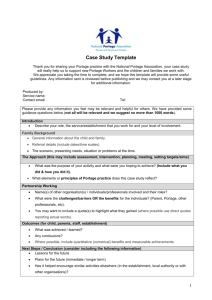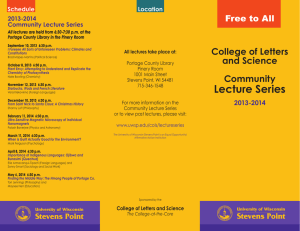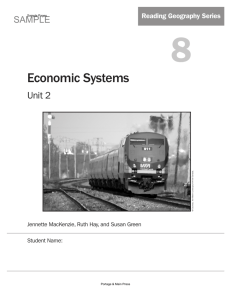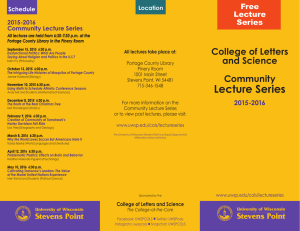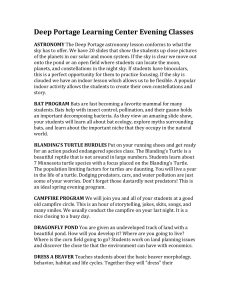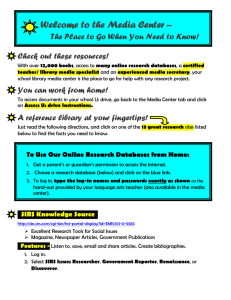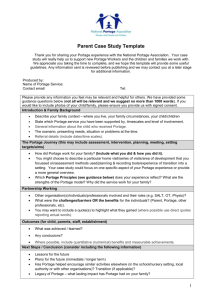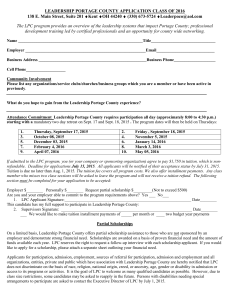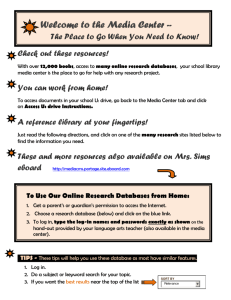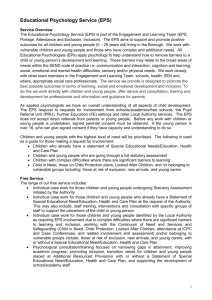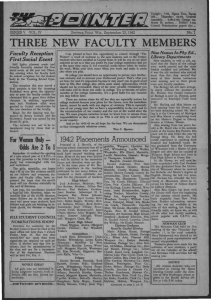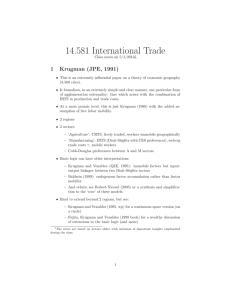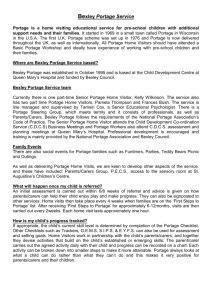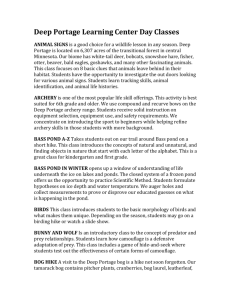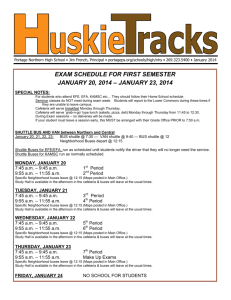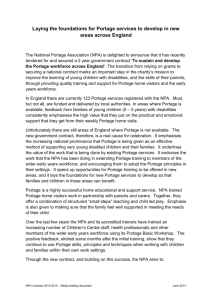Classroom Activities
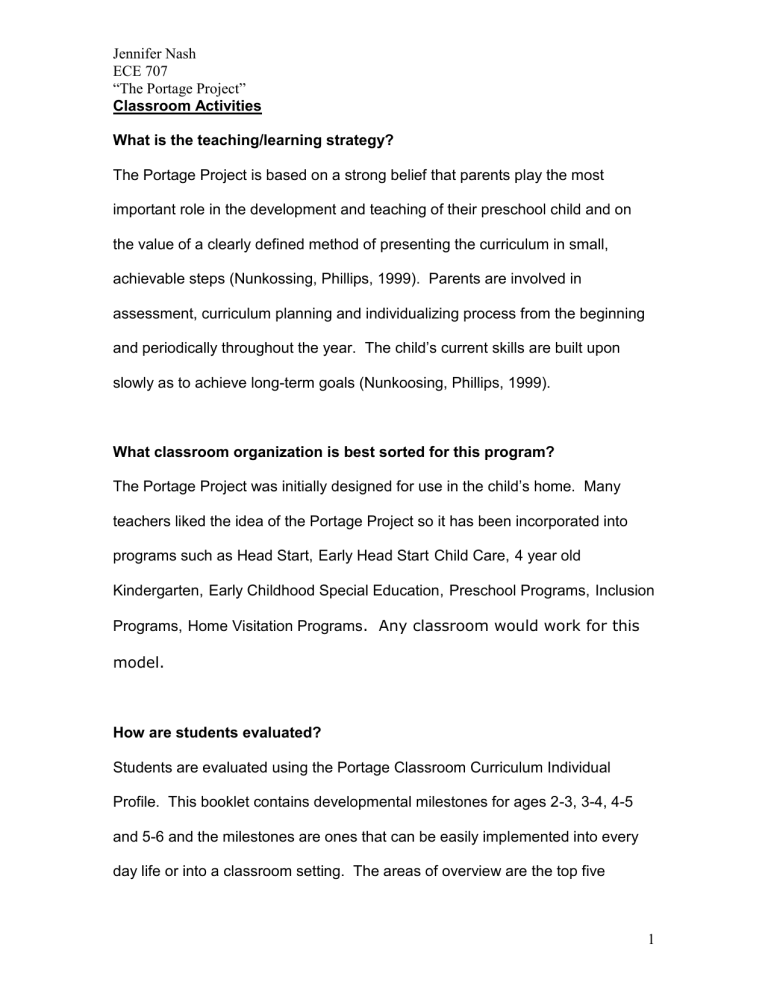
Jennifer Nash
ECE 707
“The Portage Project”
Classroom Activities
What is the teaching/learning strategy?
The Portage Project is based on a strong belief that parents play the most important role in the development and teaching of their preschool child and on the value of a clearly defined method of presenting the curriculum in small, achievable steps (Nunkossing, Phillips, 1999). Parents are involved in assessment, curriculum planning and individualizing process from the beginning and periodically throughout the year.
The child’s current skills are built upon slowly as to achieve long-term goals (Nunkoosing, Phillips, 1999).
What classroom organization is best sorted for this program?
The Portage Project was initially designed for use in the child’s home. Many teachers liked the idea of the Portage Project so it has been incorporated into programs such as Head Start, Early Head Start Child Care, 4 year old
Kindergarten, Early Childhood Special Education, Preschool Programs, Inclusion
Programs, Home Visitation Programs
. Any classroom would work for this model.
How are students evaluated?
Students are evaluated using the Portage Classroom Curriculum Individual
Profile. This booklet contains developmental milestones for ages 2-3, 3-4, 4-5 and 5-6 and the milestones are ones that can be easily implemented into every day life or into a classroom setting. The areas of overview are the top five
1
Jennifer Nash
ECE 707
“The Portage Project” developmental areas: self-help skills, motor skills, cognition, social emotional and communication. The means used to evaluate the children are as follows:
A= Always Accurately
S= Sometimes or Somewhat
N= Never or Not at all
What is a representative lesson?
First, an objective must be chosen. At the beginning of the program, only 1-2 prescriptions are chosen as not to overburden the parent since they are the ones collecting the data. As time goes on and the parent becomes a competent data collector, they will move to 3-4 prescriptions per week. An example for a 5-6 year old child would be: Child copies alphabet letters and makes complex drawings. The Portage activity cards then gives several ways for this child to be successful for the objective at hand. Some ways given are:
1. Playtime: Looking at letters helps me distinguish between them. I need direct experiences with letters so that I can compare. Display alphabet letters at my eye level in the room or provide a smaller version that I can hold in my hand. Provide alphabet matching games and puzzles and alphabet books such as Eating the Alphabet, ABC A Family Alphabet or
Miss Spider ABC.
2. Games: Play alphabet games with me. Draw part of a letter and see if I can guess what the letter is going to be.
3. Individual Time: Give me plenty of time at home or in the classroom so I can practice my writing and drawing. A writing center with a variety of
2
Jennifer Nash
ECE 707
“The Portage Project” writing tools and paper is a good way for me to learn on my own. Using a typewriter or computer keyboard will give me another opportunity to use my fine motor skills and another source for working on letters and letter recognition.
The program has chosen activities tha t occur in a preschooler’s life every day, which makes it easy to implement into classroom activities.
Parent Involvement
To what extent are parents involved?
This approach is utilized to directly involve the parents i n their child’s education.
The home teacher teaches the parents how to teach, what to reinforce and how to observe and collect data on their child’s behaviors. This is done because it is believed that much of the learning occurs in the child’s natural environment, or the home. Parents are also with their children more often than teachers generally are, so it is important to train them how to use this time to the fullest.
Parents are given 3-4 weekly goals their child is to obtain. They are then taught how to achieve these goals and also how to record the data so when the home teacher comes each week, she can see where the child is at. If the child has attained these set goals a new set will be given. If the child has not achieved them, possibly less difficult ones will be set.
3
Jennifer Nash
ECE 707
“The Portage Project”
With each weekly visit by the home teacher, she observes the teaching parent to see if they need anymore training. Recording data is an important way for parents to see the improvements their child makes daily.
Professional and Paraprofessional Training
What skills or knowledge do professionals require?
Certified special education teachers and paraprofessionals are hired and trained to be the home teachers. They received training before the start of the program which consisted of instruction in child development, assessment techniques, precision teaching, and behavior modification. They were also given pre and post tests after each instructional session to evaluate the instruction itself. Inservice trainings were held once per week and home visits were not scheduled on that day. The home teacher visited the house 1 time per week to give the parents guidance on teaching their child small achievable goals.
They also did case reviews one time per week for 2 hours. The group helped each other with difficulties met with their students. At the next meeting the teacher was to report success or failure on the matter they were seeking help for.
If failure was the result the goal needed to be changed yet again.
The home teacher must be able to take on many roles to adhere the needs of the family. They must stick to the program’s philosophy, act as an employee, advocate for the family, be an emotional supporter to the family and be a family friend (Nunkossing, Phillips, 1999).
4

